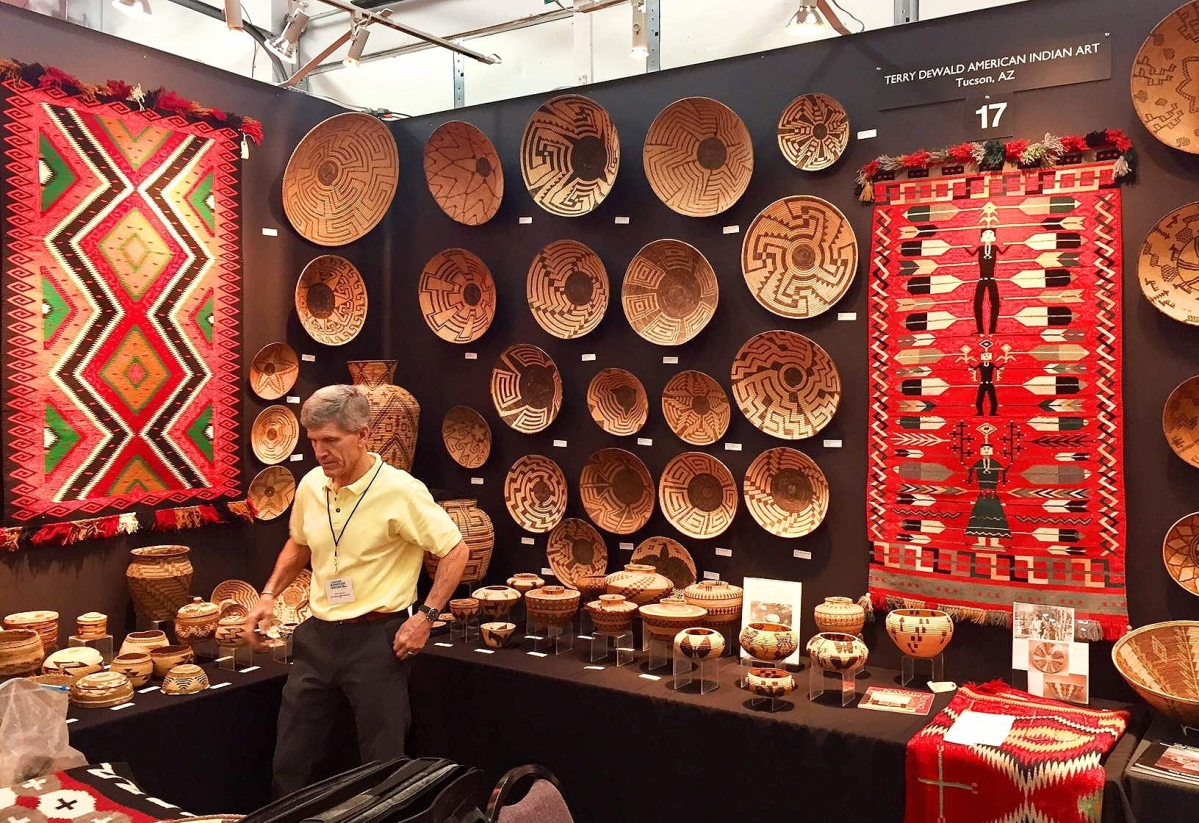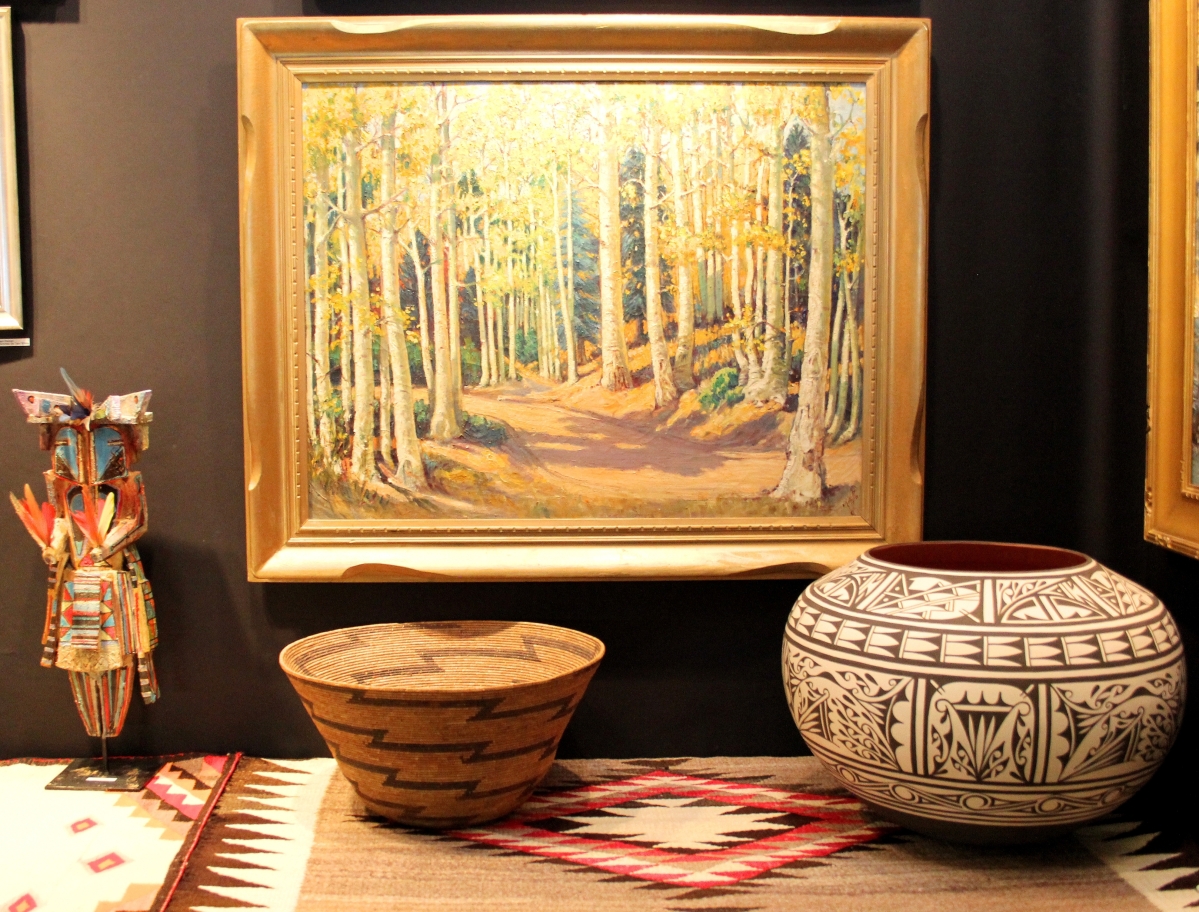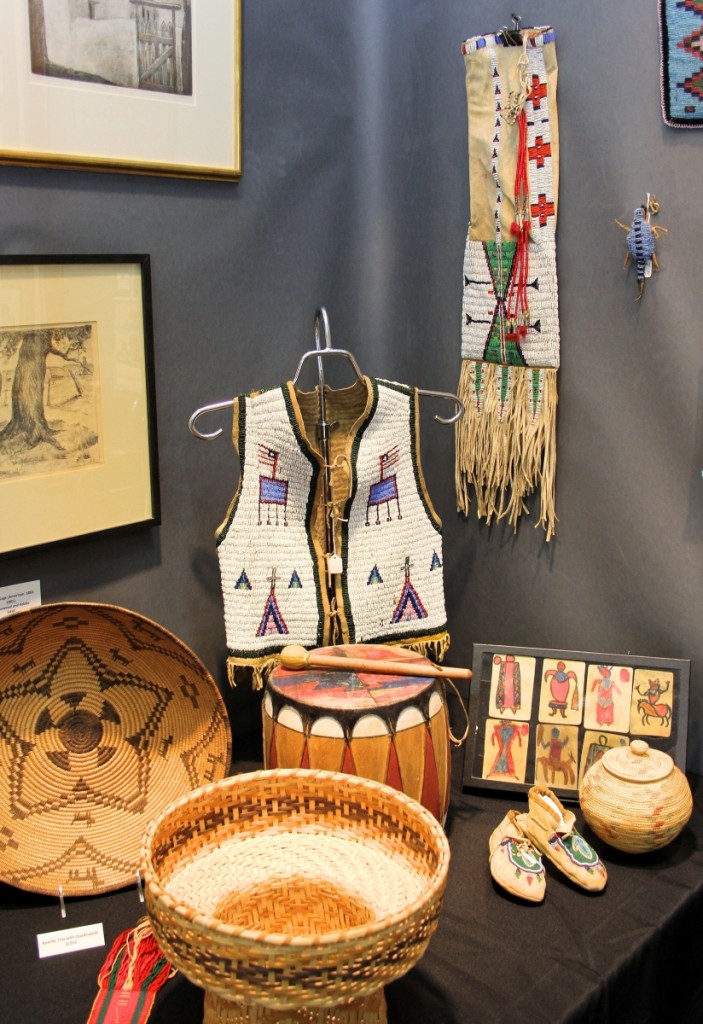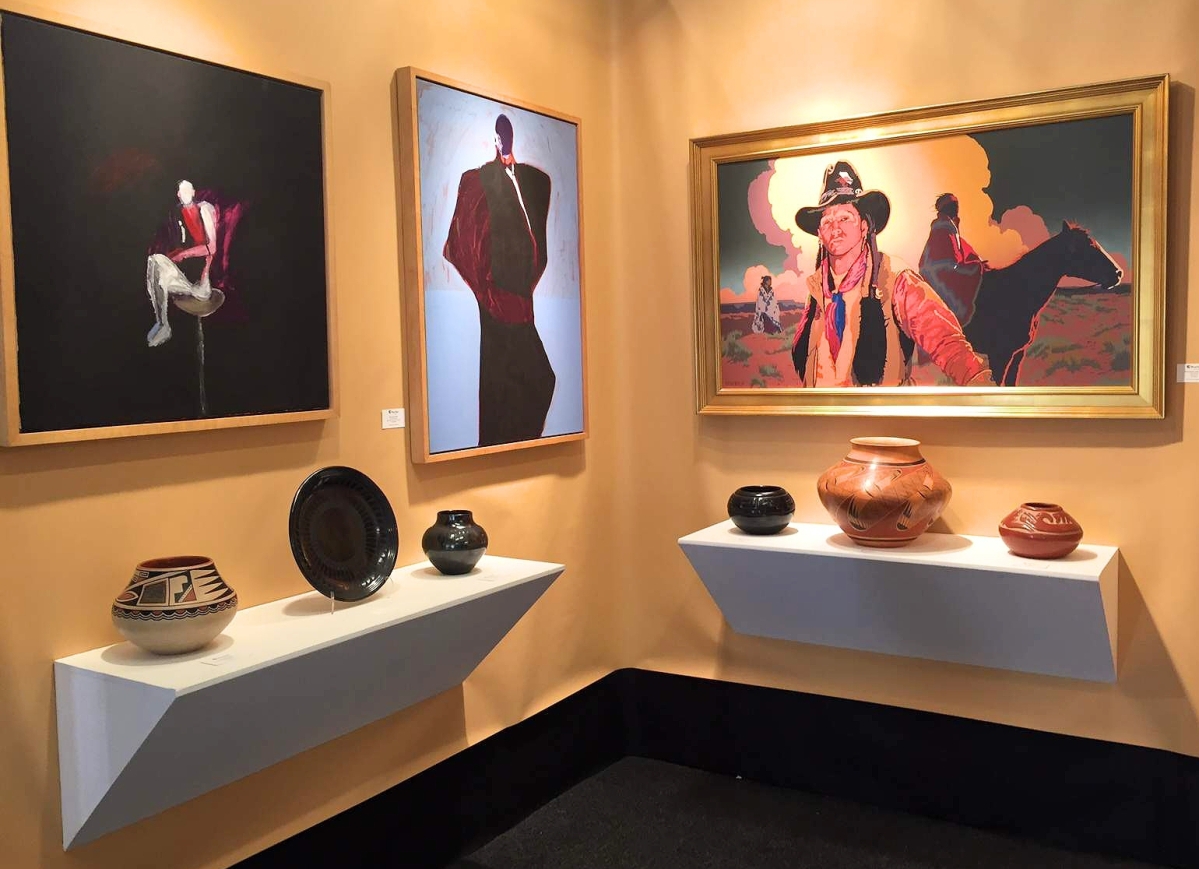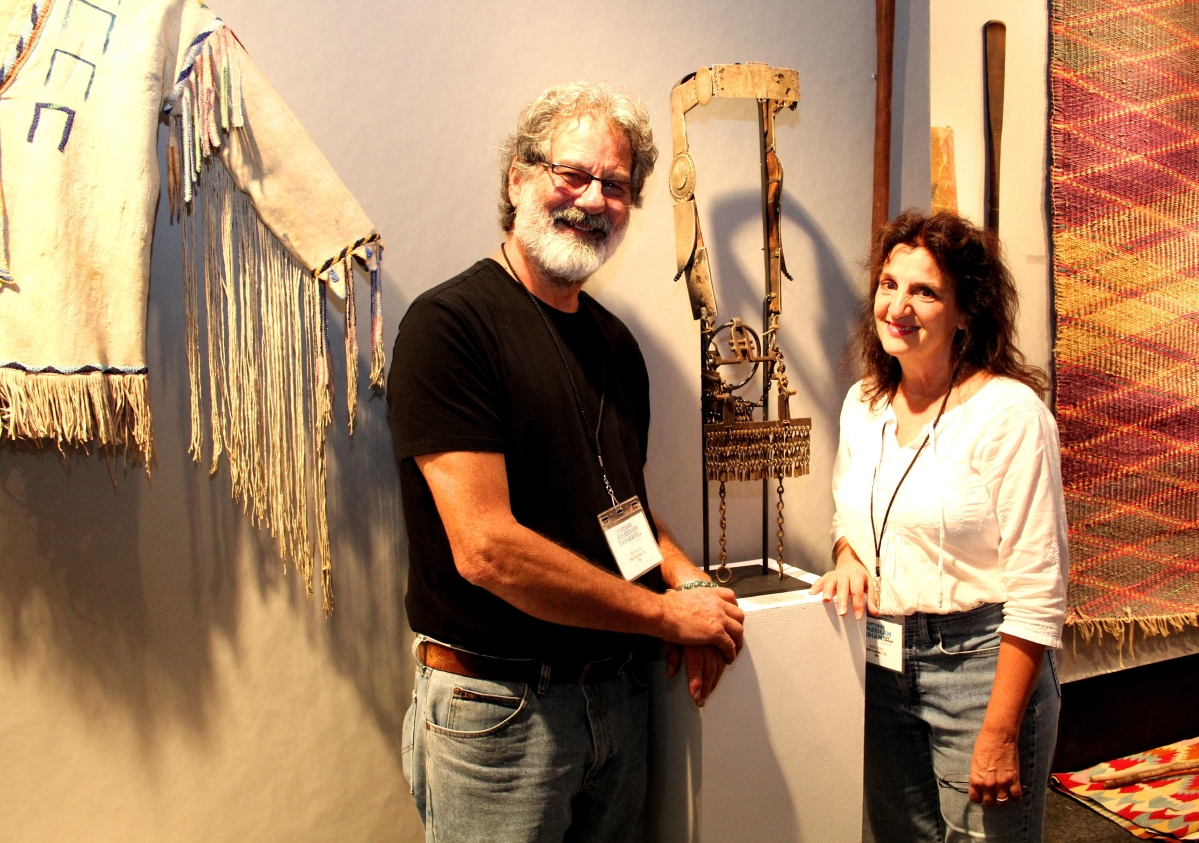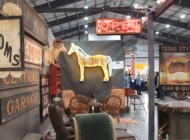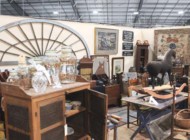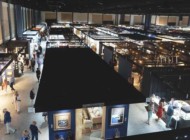Review and Photos by Laura Beach
SANTA FE, N.M. – “Everything is happening in Santa Fe in August. Here in the center of the American Indian art world, it has always been our goal to make this show the flagship, to gather together everyone who is interested in antique American Indian art,” said Kim Martindale, co-founder and co-promoter with John Morris of the Antique American Indian Art Show, one of six events annually in Los Angeles, San Francisco and Santa Fe that are part of the Objects of Art shows group.
Now in its fourth year, the event at El Museo Cultural in Santa Fe’s Railyard District got underway with a preview benefiting New Mexico PBS on Tuesday, August 15, continuing through August 18. Attendance reached 3,500. The fair’s timing is auspicious. It is the last of five shows and auctions of historic property, not to mention gallery and museum openings, that preface the nearly century-old SWAIA Santa Fe Indian Market, the largest and oldest presentation of contemporary Native American art anywhere. After several preliminary SWAIA events, Indian Market was in full swing August 18-19, drawing tens of thousands of visitors from around the world.
The Antique American Indian Art Show features roughly 65 experts in indigenous material from the United States and Canada, plus complementary Spanish Colonial, Mexican and Western fare.
Sharing two rooms with fellow Venice, Calif., dealer Philip Garaway, Martindale set a high bar with a rigorously designed presentation of Navajo weaving, Pueblo pottery and baskets. The display would have been in at home in a Modern or contemporary residence anywhere.
Less was more at H. Malcolm Grimmer, which showed drawings from the Amidon ledger book. Uniformly framed in simple, black frames, the pale sketches on lined paper depicted Sioux life immediately preceding the Reservation Period of 1880-1920. The book surfaced at a North Dakota yard sale in 1985. Grimmer is collaborating with the University of California San Diego’s Plains Indian Ledger Art Project to digitize and archive the drawings for further study. Pages ranged from a drawing of two catlike creatures, $2,000, to a graphite and colored pencil depiction, $7,500, of an armed warrior and horse. The sketches are tentatively attributed to the artist Jaw (Cehu’pa), circa 1880.
Pennsylvania dealer Brant Mackley invited collectors to schedule private views at his new Santa Fe address. Highlights of his handsome stand at the show included an early Montagnais panel bag made of brown Jesuit cloth, circa 1820-50, decorated with tiny beads forming geometric designs and spelling out the initials “RK,” not unlike a European American sampler. Two related bags reside at Harvard’s Peabody Museum. The bag is illustrated here with an engraved circa 1820-40 silver gorget made for trade with Great Lakes/Woodland natives.
Printed at Albuquerque’s renowned Tamarind Institute and from the Indians Forever suite, the 1970 lithograph “Waiting Indian” by Fritz Scholder (1937-2005) hung over a Spanish Colonial Revival blanket chest with bold rosette carvings and spiral-turned stiles at John C. Hill of Scottsdale. The Arizona dealer said the piece was most likely made in Las Vegas, N.M., around 1950. Hill shared a large booth with John Krena of Four Winds Gallery, a Pittsburgh dealer whose collections of silver and turquoise jewelry are a major attraction at the show.
Anglos were the last group to arrive in Santa Fe, which is known for its fusion of Native American and Hispano culture. One place to see expressions the latter was at Robert V. Gallegos, an Albuquerque dealer with an impressive inventory of Hispano punch-decorated tin and rare bultos and retablos by New Mexican masters such as the Santo Nino Santero, George Lopez, Patrocinio Barela and Jose Aragon. Blue and ivory on a chocolate ground, a New Mexican colcha embroidery was an appealing find at Cowboys and Indians Antiques, also of Albuquerque.
Coming off a spectacular 2016 show in Santa Fe, Shrub Oak, N.Y., dealers Ted Trotta and Anna Bono offered serious collectors a range of historic objects, from a circa 1780 quilled pouch, most likely Great Lakes-Ottawa or Delaware, to a lightly beaded Apache man’s shirt dating to the second half of the Nineteenth Century. Of note was a horse’s silver headstall made by the Navajo Atsidi Chon, who was taken as a slave into a Hispanic family in New Mexico around 1870. The headstall, which combines Indian and Hispanic decorative elements, belonged to the great dealer, collector and scholar Larry Frank, who featured it in his seminal book Indian Silver Jewelry of the Southwest 1868-1930.
“It is an exuberant piece for an exceptional child of high rank,” dealer Julie Kokin Miller said of a Nineteenth Century Nez Perce boy’s shirt made of trade cloth decorated with old pony beads in the Sherwoods Spirit of America display, which also featured a set of four Great Lakes/Potawatomi horse effigy drum holders and Cheyenne, Lakota and Delaware bags.
Satisfying a craving for Northern fare in a setting that tilts to the Southwest, John Molloy Gallery impressed with a Yukon River Athabascan man’s outfit. Nearby were Huron moose hair embroidered moccasins of the mid-Nineteenth Century, an Inuit Nunivak Island mask and Inuit drum frame, and a Kwakwaka’wakw raven mask of about 1930-40. The New York City dealers brought Blackfoot, Lakota, Crow and Hopi artifacts, as well.
A carved and painted Kwakiutl articulated mask stopped traffic at Seattle dealer James Flury. Edward Curtis published the fierce sculpture fashioned as a bird’s head around 1900. The mask joined a Bella Bella carving of circa 1900 and an intriguing group of 15 decorated Eskimo bails. Chilkat weavings from the Northwest Coast hung across the way at Jeffrey Myers of New York City and were also found at Irwin and Marjorie Goodman of Wayne, N.J., AE Tribal Antiques of Laguna Niguel, Calif.; and at Written Heritage, Folsom, La.
Special exhibitions, many of them outstanding and often sourced from exhibitors’ personal collections, are a regular feature of the Objects of Art shows. Accompanied by a 112-page color catalog, Mark Sublette Medicine Man Gallery’s presentation “Homage to the Square: Navajo Masterpieces 1860-1950” was breathtaking. Sublette, who maintains a 7,000-square-foot gallery in Tucson and a website packed with Native American, Western and Mexican art and antiques, said he has been collecting the weavings for 25 years.
“It took me four years to put this show together. I looked for oddball rugs and blankets, not those in the recognizable patterns favored by trading posts. The weavings I selected are characterized by their bold design sensibility and unusual, often vibratory color composition,” Sublette told us. The expert paired the textiles with screen prints by Josef Albers (1888-1976) and paintings by Jorge Fick (1932-2004). “Albers liked Navajo blankets,” said Sublette, whose catalog reproduces two 1938 photos from the Albers archive, one showing the color theorist and teacher posing with a simple, geometric Navajo weaving, circa 1900-10, from the trading post at Crystal, N.M. “Homage to the Square” will be on view at Medicine Man Gallery this fall. Sublette is planning a Maynard Dixon (1875-1946) exhibit for next year.
Fine art spanned the gamut, from a painting on hide at Brant Mackley to watercolors by the Pueblo easel painters Awa Tsireh and Pablita Velarde at Blue Rain Gallery. Two of Santa Fe’s hottest contemporary talents, Tony Abeyta (b 1965) and Darren Vigil Gray (b 1959) were represented by Blue Rain and Trotta-Bono. Blue Heron Gallery showed work by Anglo artists with ties to Santa Fe, among them printmaker Gustave Baumann (1881-1971) and the Transcendental group painter Raymond Jonson (1891-1982).
Terry DeWald’s dazzling display juxtaposed colorful Navajo blankets and a profusion of baskets. The Tucson dealer has been doing shows with Kim Martindale and his late colleague, Don Bennett, for decades. DeWald even remembers sleeping with a gun on a cot in a ballroom of the Santa Fe Hilton, where an earlier incarnation of this antiques show was mounted, after Bennett asked him to serve as night watchman.
“Art really changes your life. The more you learn about it, the more irresistible it becomes,” DeWald told us. We could not agree more.
It is worth making plans to be in northern California for the 34th Annual American Indian Art Show Marin, scheduled for February 17-18 in San Rafael. The fair is organized on consecutive weekends with the San Francisco Tribal & Textile Art Show, February 8-11. Both are Objects of Art productions.
The Antique American Indian Art Show Santa Fe returns to El Museo Cultural August 14-17, 2018.
For additional information, www.objectsofartshows.com or 310-822-9145.

